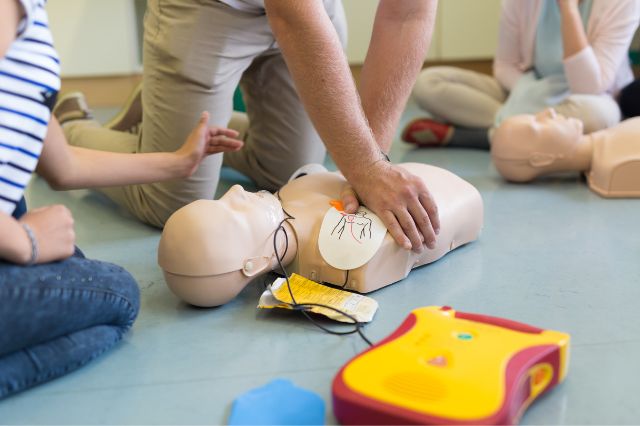AEDs in Schools: Protecting the Lives of Students and Staff

The American Heart Association reports that a sudden cardiac arrest cuts short the lives of over 7,000 school-going children annually. Plus, an out-of-hospital cardiac arrest (OHCA) often results in death since it can take medical professionals up to ten minutes or more to respond.
By having an AED device on-site, schools can offer their students and staff a life-saving action plan in case of a cardiac emergency. To that end, an AED machine by AED Advantage Sales could ensure someone in a school setting lives to realize their dreams.
What is an AED?
Basically, it’s a lightweight, computerized medical device that can quickly assess the heart rhythm of a person in cardiac arrest. And, if necessary, it can deliver an electric shock to the heart (through the chest) to restore a normal rhythm.
In contrast to the manual defibrillators available in the past, AEDs are extremely user-friendly. They don’t need a medical professional to operate. Their intuitive interface, with voice, prompts, text messages or visual cues, makes them easy to operate in a time-sensitive situation.
Up to 70 percent of victims who experience an out-of-hospital cardiac arrest and receive defibrillation within three minutes survive, making AEDs a vital life-saving tool. Similarly, defibrillation within the first minute improves chances of survival by up to 86 percent – according to the American Heart Association.
Thus, prompt action could save a life. Unfortunately, this isn’t always the case. Without an AED, the only help a victim can get is manual CPR, which can only do so much.
AEDs are mandated in 20 US states, meaning schools in these states are legally required to have AEDs. In Canada, some provinces are taking steps to ensure AEDs are available. For instance, in Nova Scotia, the government is proactively equipping public schools with AEDs.
This implies that the presence of AEDs in schools is becoming increasingly necessary. Thus, even if it’s not a requirement, schools should consider investing in an AED to ensure their students and staff are safe – especially considering the significant proportion of our population currently enrolled in schools.
Benefits of Implementing an AED Program in Schools
Besides saving lives, AEDs offer countless other benefits. Let’s highlight some of the top advantages of deploying them in schools:
- Increased sense of security and peace of mind – Knowing that a life-saving device is within reach can assure staff, students and parents that should the unfortunate occur, necessary help is available.
- Better community relations – Schools can strengthen their bond with the local community by hosting AED awareness campaigns, training programs and other cardiac safety initiatives. Investing in AEDs also implies schools are paying attention to the well-being of their population, which bodes well for their public image.
- Improved response time – An AED is always ready to go, implying you don’t have to wait for first responders to deal with a cardiac emergency. You can deploy the device immediately and coordinate with paramedics to provide care.
- Proven track record – Many public places, such as airports and stadiums, deploy AEDs and have reported success. Hence, investing in such devices isn’t a shot in the dark; it’s a worthwhile investment.
- Enhanced awareness of cardiac risks – The proliferation of AEDs increases public knowledge about the dangers of cardiac issues and how to recognize them. More so, AED programs can offer staff and pupils training on how to use the devices in case of an emergency. Likewise, they can perform drills to ensure everyone is ready in case of an eventuality.
Maintenance and Training Are Key
Having a properly maintained AED is equally as important as having one in the first place. Checkups and regular inspections are necessary to ensure the device is operational and ready when needed. Thus, maintenance typically entails:
- Periodic inspections to check for wear and tear
- Testing the primary and backup battery
- Replacing batteries (every 3 to 5 years) and pads as necessary
- Keeping the device charged
- Checking the data card – some units have a card that stores information regarding usage, shocks delivered, and other aspects.
Moreover, your school’s AED program should include a detailed response plan outlining what people should do during an emergency. Such plans are vital for legal compliance and general awareness. It also pays to ensure staff members, who’ve undergone training for AEDs, know how to use it correctly and understand the basics of cardiopulmonary resuscitation (CPR).
We can’t afford to leave the lives of our children, educators, and other school staff to chance. AEDs can promote safety in schools and save lives. They might seem like a costly investment, but when you consider the grave implications of not having them, the cost pales in comparison.




